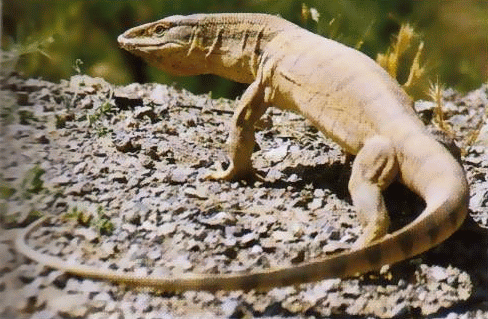
| Local Name: | Goa (Urdu) |
| Family: | VARIANIDAE |
| Genus: | Varanus |
| Status: | Common to Rare |
| Warning: | This lizard inflicts a powerful bite with its long, strong and sharp teeth, that can cause dizziness, muscular aches, pains, accelerated heartbeat and difficulty breathing through the mouth |
The Desert or Grey Monitor has a snout-vent length 560-579 mm, tail 865-870 mm.
In the Desert Monitor the Dorsum is gray to yellowish brown; body and tail with brownish crossbars; 2-3 streaks on neck; ventrum yellowish. In adult vivacity of dorsal pattern is lost.
In the Transcaspian Desert Monitor sub specie the body has 5-6, while tail has 16-19 transverse bands.
Males tend to be longer than females (largest male recorded from Turkmenistan by Shammakov (1981) was 58.5cm SVL, largest female was 46cm) but not much heavier (heaviest male was 2,850g heaviest female 2,700g). It is the largest race of the desert monitor. The Transcaspian Desert Monitor is distinguished from other races of V.griseus largely by the shape of its tail, which is laterally compressed in contrast to the tails of other races, which tend to be more or less rounded in cross section.
The Indo-Pak sub specie has 4 transverse bands, while the tail has 10-15 transverse bands. Indo-Pak Desert Monitor is the smallest subspecies of V.griseus. Males reach a maximum length of 84cm TL (37cm SVL) and a weight of 580g. Females grow to 75cm TL (34cm SVL) and weigh up to 520g. Sexual maturity, for females at least, is attained at about 24cm SVL.
